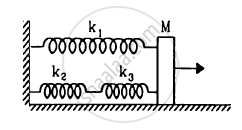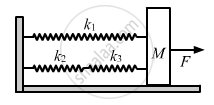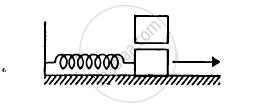Advertisements
Advertisements
प्रश्न
The springs shown in the figure are all unstretched in the beginning when a man starts pulling the block. The man exerts a constant force F on the block. Find the amplitude and the frequency of the motion of the block.

उत्तर

As the block of mass M is pulled, a net resultant force is exerted by the three springs opposing the motion of the block.
Now, springs k2 and k3 are in connected as a series combination.
Let k4 be the equivalent spring constant.
\[\therefore \frac{1}{k_4} = \frac{1}{k_2} + \frac{1}{k_3} = \frac{k_2 + k_3}{k_2 k_3}\]
\[ k_4 = \frac{k_2 k_3}{k_2 + k_3}\]
k4 and k1 form a parallel combination of springs. Hence, equivalent spring constant k = k1 + k4.
\[= \frac{k_2 k_3}{k_2 + k_3} + k_1 \]
\[ = \frac{k_2 k_3 + k_1 k_2 + k_1 k_3}{k_2 + k_3}\]
\[ \therefore \text { Time peiod }, T = 2\pi\sqrt{\frac{M}{k}}\]
\[ = 2\pi\sqrt{\frac{M \left( k_2 + k_3 \right)}{k_2 k_3 + k_1 k_2 + k_1 k_3}}\]
(b) Frequency \[\left( v \right)\] is given by,
\[v = \frac{1}{T}\]
\[= \frac{1}{2\pi}\sqrt{\frac{k_2 k_3 + k_1 k_2 + k_1 k_3}{M\left( k_2 + k_3 \right)}}\]
(c) Amplitude ( x ) is given by,
\[x = \frac{F}{k} = \frac{F\left( k_2 + k_3 \right)}{k_1 k_2 + k_2 k_3 + k_1 k_3}\]
APPEARS IN
संबंधित प्रश्न
A particle is in linear simple harmonic motion between two points, A and B, 10 cm apart. Take the direction from A to B as the positive direction and give the signs of velocity, acceleration and force on the particle when it is
(a) at the end A,
(b) at the end B,
(c) at the mid-point of AB going towards A,
(d) at 2 cm away from B going towards A,
(e) at 3 cm away from A going towards B, and
(f) at 4 cm away from B going towards A.
A particle having mass 10 g oscillates according to the equation x = (2.0 cm) sin [(100 s−1)t + π/6]. Find (a) the amplitude, the time period and the spring constant. (c) the position, the velocity and the acceleration at t = 0.
A body of mass 2 kg suspended through a vertical spring executes simple harmonic motion of period 4 s. If the oscillations are stopped and the body hangs in equilibrium find the potential energy stored in the spring.
The block of mass m1 shown in figure is fastened to the spring and the block of mass m2 is placed against it. (a) Find the compression of the spring in the equilibrium position. (b) The blocks are pushed a further distance (2/k) (m1 + m2)g sin θ against the spring and released. Find the position where the two blocks separate. (c) What is the common speed of blocks at the time of separation?

Find the elastic potential energy stored in each spring shown in figure, when the block is in equilibrium. Also find the time period of vertical oscillation of the block.
Solve the previous problem if the pulley has a moment of inertia I about its axis and the string does not slip over it.
A 1 kg block is executing simple harmonic motion of amplitude 0.1 m on a smooth horizontal surface under the restoring force of a spring of spring constant 100 N/m. A block of mass 3 kg is gently placed on it at the instant it passes through the mean position. Assuming that the two blocks move together, find the frequency and the amplitude of the motion.

When a particle executing S.H.M oscillates with a frequency v, then the kinetic energy of the particle?
A body is executing simple harmonic motion with frequency ‘n’, the frequency of its potential energy is ______.
A body is executing simple harmonic motion with frequency ‘n’, the frequency of its potential energy is ______.
A body is executing simple harmonic motion with frequency ‘n’, the frequency of its potential energy is ______.
Motion of an oscillating liquid column in a U-tube is ______.
A body is performing S.H.M. Then its ______.
- average total energy per cycle is equal to its maximum kinetic energy.
- average kinetic energy per cycle is equal to half of its maximum kinetic energy.
- mean velocity over a complete cycle is equal to `2/π` times of its π maximum velocity.
- root mean square velocity is times of its maximum velocity `1/sqrt(2)`.
Find the displacement of a simple harmonic oscillator at which its P.E. is half of the maximum energy of the oscillator.
A body of mass m is attached to one end of a massless spring which is suspended vertically from a fixed point. The mass is held in hand so that the spring is neither stretched nor compressed. Suddenly the support of the hand is removed. The lowest position attained by the mass during oscillation is 4 cm below the point, where it was held in hand.
What is the amplitude of oscillation?
